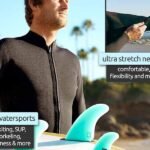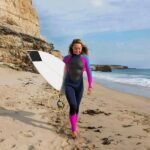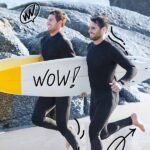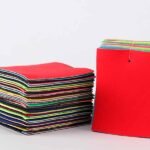Children and water are a natural combination — splashing, laughing, exploring. But the moment a child’s teeth begin to chatter, even the happiest beach day can end early. That’s where the toddler wetsuit comes in: a soft, flexible, insulating layer that lets your little one enjoy the water longer, safely, and comfortably. Yet, for many parents and buyers, choosing the right wetsuit involves more than picking a cute color or brand name. It’s about understanding neoprene science, fit precision, and safety factors designed specifically for small bodies.
A toddler wetsuit is a snug neoprene suit that helps young children retain body heat in cold or windy water. It provides buoyancy, UV protection, and a soft barrier against scrapes or jellyfish stings. The ideal wetsuit depends on water temperature, neoprene thickness, and proper sizing. A well-fitting wetsuit keeps toddlers warm, flexible, and safe during swimming, surfing, or beach play.
Think of it this way — a good toddler wetsuit is not just apparel; it’s a piece of equipment. The same neoprene technology used in professional surf suits is scaled down for miniature explorers, combining safety and fun. In the next sections, we’ll walk through what makes a toddler wetsuit effective, how to choose the right one, and what details separate an ordinary product from one designed with true care.
What is a Toddler Wetsuit and Why Does It Matter?
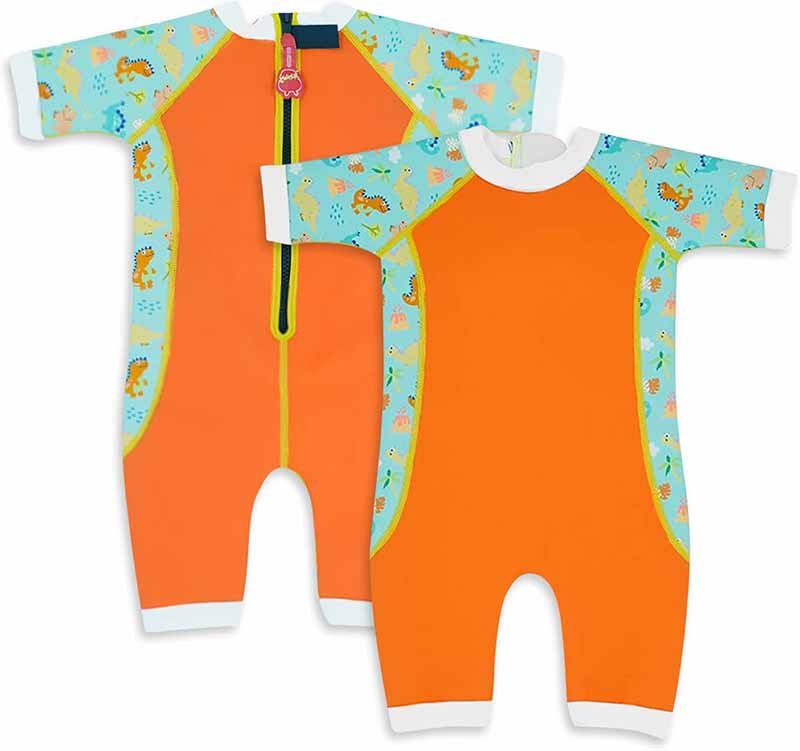
A toddler wetsuit is a small-sized thermal garment made from neoprene, designed to keep young children warm and protected in water. It works by trapping a thin layer of water between the body and the suit, which quickly warms to body temperature. This insulation, combined with snug fit and UV coverage, helps toddlers stay safe, buoyant, and comfortable during swimming or beach activities.
Unlike adults, toddlers lose body heat up to four times faster due to smaller body mass and thinner skin. Their comfort threshold in water is much narrower — a drop from 86°F to 75°F (30°C to 24°C) can cause shivering in minutes. That’s why neoprene wetsuits are essential: they act as thermal shields, reducing heat loss through a controlled layer of water next to the skin.
Modern toddler wetsuits are made primarily from closed-cell neoprene foam, a synthetic rubber filled with nitrogen bubbles that trap warmth and enhance buoyancy. This structure makes the material flexible, water-resistant, and shock-absorbent — perfect for protecting a child’s sensitive skin from sharp shells or rough pool edges.
Wetsuits for toddlers also provide UV protection (UPF 50+), preventing sunburns when playing for long hours on the beach. Some designs feature reinforced knees, flatlock stitching to avoid chafing, and back zippers for easy wear — small details that make a huge difference for parents and kids alike.
Another overlooked advantage: safety visibility. Bright colors like orange, aqua, or lime make it easier to spot a child in crowded water parks or beaches, enhancing safety and peace of mind.
How Should You Choose the Right Thickness and Material for a Toddler Wetsuit?
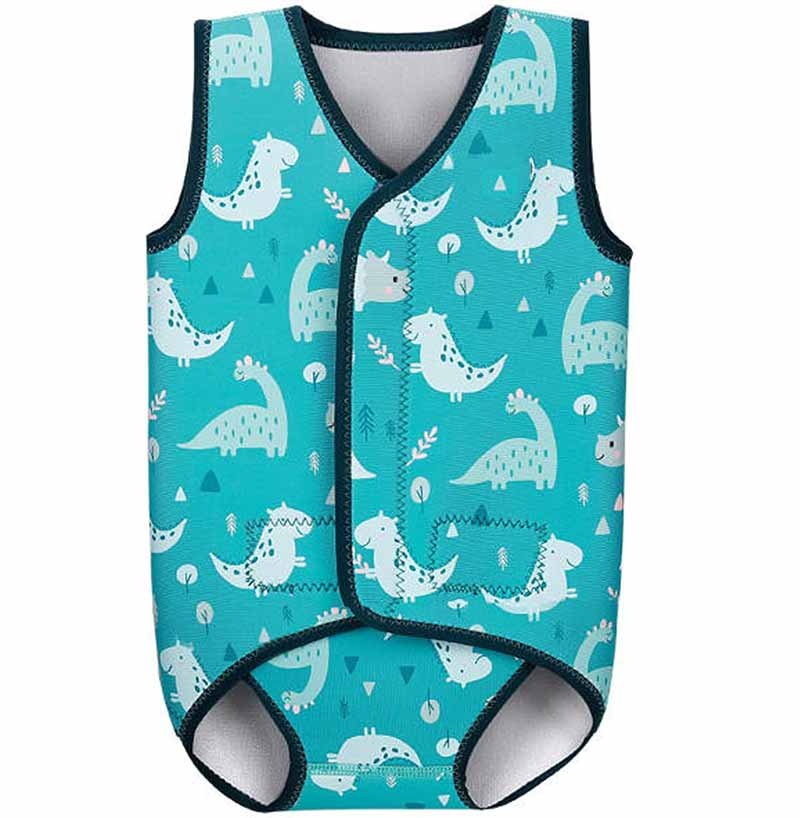
Choose a wetsuit thickness based on water temperature. For warm tropical waters (75–85°F), a 2 mm shorty is ideal. For mild to cool waters (65–75°F), choose a 3/2 mm full suit. Below 65°F, consider a 4/3 mm or thicker neoprene. Look for super-stretch neoprene that balances insulation with mobility — soft enough for easy dressing but dense enough for warmth and durability.
Parents often ask, “How thick should my toddler’s wetsuit be?” The answer lies in understanding neoprene thickness and its impact on both warmth and flexibility.
Here’s a simple reference chart:
| Water Temperature (°F) | Wetsuit Thickness | Recommended Style | Usage Example |
|---|---|---|---|
| 80°F + (27°C +) | 1–2 mm | Shorty / Springsuit | Pool, tropical beach |
| 70–79°F (21–26°C) | 2–3 mm | Full suit or shorty | Coastal swim, surf schools |
| 60–69°F (16–20°C) | 3/2 mm – 4/3 mm | Full suit | Cooler surf or lake water |
| Below 60°F (16°C) | 5 mm + | Thermal full suit | Cold lakes, diving practice |
Tip: The first number (e.g., “3/2 mm”) represents torso thickness for warmth, and the second number (2 mm) represents limb thickness for mobility.
The material’s quality and cell density determine comfort and insulation. High-end neoprene — such as super-stretch or limestone neoprene — feels buttery soft and moves with the child, unlike stiffer, cheaper variants that restrict motion or cause chafing. Premium neoprene also resists compression, maintaining warmth even after repeated use or drying.
Texture and lining also matter. Many toddler wetsuits use plush thermal lining inside to make dressing easier and add comfort. Nylon or spandex outer layers improve stretch and color retention, while flatlock seams prevent water leakage and skin irritation.
Parents buying for toddlers aged 1–4 should also consider ease of dressing. A thicker wetsuit (4 mm+) can be warm but hard to put on; a 2–3 mm super-stretch suit offers the best compromise for comfort and warmth in most climates.
Which Size and Fit Considerations Are Crucial for Toddler Wetsuits?

A toddler wetsuit should fit snugly but not restrict movement. It should feel like a second skin—tight enough to prevent cold water from flushing through, yet flexible at the shoulders, arms, and legs. Avoid sizing up for “room to grow,” since loose suits allow cold water to circulate, defeating insulation. Always measure height, weight, chest, and waist before buying or ordering a custom-fit wetsuit.
Sizing is the most overlooked yet most critical part of wetsuit selection. Parents often think, “They’ll grow into it.” But wetsuits aren’t like T-shirts—if it’s too loose, it simply doesn’t work. Proper fit ensures thermal insulation, buoyancy, and mobility—all three of which are essential for toddlers’ comfort and safety.
Why Tightness Matters:
Neoprene works by trapping a thin layer of water between the body and suit. This layer warms up quickly to body temperature. A loose wetsuit constantly lets cold water flow in, causing heat loss and shivering. Conversely, one that’s too tight restricts blood flow and movement.
Ideal Fit Indicators:
- The wetsuit should form light contact over the torso, arms, and thighs with no visible folds.
- The neckline should sit comfortably without gaping or choking.
- When your child raises their arms or squats, the suit should stretch smoothly without tension lines.
Toddler Wetsuit Size Chart (General Reference)
| Age (Years) | Height (in / cm) | Weight (lbs / kg) | Recommended Size | Notes |
|---|---|---|---|---|
| 1–2 | 31–35″ / 79–89 cm | 22–26 lbs / 10–12 kg | 1T / XS | For splash play & warm water |
| 2–3 | 35–38″ / 89–97 cm | 26–30 lbs / 12–14 kg | 2T / S | Ideal for pool lessons or beaches |
| 3–4 | 38–41″ / 97–104 cm | 30–35 lbs / 14–16 kg | 3T / M | Transition age for full wetsuits |
| 4–5 | 41–44″ / 104–112 cm | 35–40 lbs / 16–18 kg | 4T / L | Choose 3/2 mm for cooler waters |
| 5–6 | 44–48″ / 112–122 cm | 40–45 lbs / 18–20 kg | 5T / XL | Use for surfing or cold pools |
Signs of Poor Fit
- Baggy Areas: Water flushes through, causing chills.
- Wrinkled Knees or Armpits: Indicates excess length or incorrect torso proportion.
- Difficulty Zipping: Too small; can strain seams or restrict breathing.
- Red Marks After Use: Too tight around neck or joints—try one size up or a softer neoprene type.
Pro Tip:
If you’re purchasing for a fast-growing toddler, prioritize comfort and flexibility. Instead of upsizing, look for super-stretch neoprene or adjustable closures at the neck and cuffs. These extend usability without compromising insulation.
Why Custom Fit Matters for Brands and Buyers
For retailers, schools, or brands ordering toddler wetsuits in bulk, consistent sizing is key. Custom-fit options allow you to maintain reliable proportions across different batches. This reduces returns, enhances comfort, and improves customer satisfaction. Many professional buyers now request custom size grading tables from their OEM partners to match regional growth standards (US, EU, or AU children’s charts).
A well-fitting wetsuit does more than keep a child warm—it gives them confidence to play, explore, and enjoy the water without fear of discomfort.
What Style and Entry Systems Should You Look for in Toddler Wetsuits?
Toddler wetsuits come mainly in two styles—shorty (short sleeves and legs) for warm waters, and full suits for colder conditions. Choose front or back zippers for easy dressing. For very young children, wide-opening designs or Velcro shoulder entries make changing faster. The right style balances warmth, mobility, and convenience based on the activity and temperature.
Toddlers don’t tolerate discomfort for long, so the right wetsuit style can make or break their first swimming experience. Each type has unique advantages depending on temperature, activity, and how often the suit will be used.
Style Comparison Table: Shorty vs. Full-Length
| Feature | Shorty Wetsuit | Full-Length Wetsuit |
|---|---|---|
| Coverage | Torso, upper arms, thighs | Full body (ankles to wrists) |
| Water Temperature | 75–85°F (24–29°C) | 60–75°F (15–24°C) |
| Ease of Dressing | Easier, faster for parents | Slightly longer to put on |
| Warmth Level | Light to moderate | High thermal insulation |
| Flexibility | Excellent, less restrictive | Slightly tighter fit on limbs |
| Best For | Pools, tropical coasts, casual play | Surf lessons, cooler beaches, extended swimming |
| Lifespan | Outgrown quickly but affordable | Longer-lasting for frequent use |
Entry System Comparison
| Entry Type | Advantages | Ideal Age Range | Notes |
|---|---|---|---|
| Back Zip | Classic style; easy for parents to zip | 2–6 yrs | Common in surf wetsuits; watch for chafing near spine |
| Front Zip | Easier self-dressing; good airflow | 3–6 yrs | Great for warm climates; more flexible neck |
| Shoulder Velcro / Side Entry | Best for toddlers under 2 | 1–3 yrs | Wide opening, easier diaper changes |
| Step-in Suit (no zip) | Soft and flexible | 1–3 yrs | Ideal for splash play; limited insulation |
Design Details That Matter
- Seam Construction: Look for flatlock seams (soft, flexible) for warm water, or glued & blind-stitched seams (GBS) for cold water, as they prevent leaks.
- Knee & Elbow Reinforcement: Toddlers crawl, climb, and sit—reinforced panels extend the suit’s life.
- Collar Design: Adjustable Velcro necks reduce choking risk and make fitting faster.
- Color & Visibility: Bright, high-contrast colors improve visibility at the beach or pool.
- Print Customization: Logos, patterns, and themes (e.g., sea animals, superheroes) encourage kids to wear the suit happily.
Choosing Based on Use Case
- For Beach Trips: 2 mm shorty suits with fun prints are perfect for warm climates.
- For Swimming Lessons: 3/2 mm full suits improve buoyancy and warmth for longer sessions.
- For Surfing or Paddle Sports: Full suits with reinforced knees and flexible shoulders allow maximum range of motion.
- For Cold Lakes or Extended Exposure: 4/3 mm GBS-stitched suits maintain heat longer and resist wind chill.
Parental Insight:
Ease of dressing matters more than most realize. Children’s patience is short, especially when cold. Zipperless or Velcro-assisted designs save time and tears. Many parents describe the “two-minute rule”: if it takes longer than that to dress your toddler, they’ll likely resist the next time.
How to Care for a Toddler Wetsuit and Extend Its Lifespan

Rinse a toddler wetsuit in fresh water after every use, dry it in the shade, and store it flat or on a wide hanger. Avoid hot water, direct sunlight, or harsh detergents that degrade neoprene. Regularly check zippers, seams, and cuffs for damage. With proper care, a quality neoprene wetsuit lasts one to two years of active toddler use — even longer for hand-me-downs.
Many parents treat wetsuits like swimsuits — quick rinse, hang in the sun, done.
But neoprene is a technical material, not just fabric. Its insulating bubbles can collapse, its adhesive seams can weaken, and its elasticity can vanish if exposed to heat, UV, or chemicals.
1. Rinse Immediately After Use
Salt, chlorine, and sand crystals are neoprene’s worst enemies.
After swimming, rinse the suit thoroughly with fresh, cool water. For saltwater use, submerge the suit in a bucket or bathtub for 10 minutes to dissolve residual salt.
Avoid: machine washing, wringing, or twisting — it distorts seam glue and shortens the suit’s life.
2. Dry the Right Way
Neoprene hates heat.
Always air-dry in a shaded, ventilated place. Never under direct sunlight or near heaters.
Turn the suit inside-out halfway through to ensure the interior dries completely — trapped moisture breeds mildew and odor.
3. Store Correctly
Hang the wetsuit on a wide, rounded hanger (avoid thin wire hangers) or lay it flat. Folding creates permanent creases that thin the neoprene cells.
If space is limited, roll rather than fold.
4. Inspect Before and After Use
Look for small tears, stretched seams, or corrosion around zippers. Most damage starts small — a quick dab of neoprene cement or a patch kit can double the suit’s lifespan.
Tip: Encourage toddlers to step on a towel, not concrete, while changing. It prevents abrasion and keeps sand out of the lining.
Toddler Wetsuit Maintenance Checklist
| Task | Frequency | Why It Matters |
|---|---|---|
| Rinse with fresh water | After each use | Removes salt & chlorine that break down neoprene |
| Air dry in shade | After each use | Prevents UV damage and odor build-up |
| Turn inside out mid-dry | Every time | Ensures complete drying of lining |
| Inspect seams and zippers | Weekly during season | Early repair prevents leaks |
| Store flat or on wide hanger | Always | Avoids creasing and stretching |
| Use neoprene cleaner | Monthly | Restores elasticity & kills bacteria |
With these habits, parents can easily extend the lifespan by 40–60 percent compared with poorly maintained suits.
That means fewer replacements, less waste, and a higher resale or hand-me-down value — especially when the wetsuit was built with premium, high-density neoprene.
Are There Special Safety and Performance Considerations for Toddlers Using Wetsuits?
Yes. Toddler wetsuits must balance warmth, buoyancy, and unrestricted movement while ensuring UV and abrasion protection. Look for UPF 50+ fabric, flexible panels under arms and knees, smooth-skin neck seals, and bright colors for visibility. However, wetsuits are not flotation devices — adult supervision and life jackets remain essential for water safety.
A toddler wetsuit is both protective gear and comfort wear.
Safety starts not only with the child’s ability in water but also with how the wetsuit supports that ability.
1. Thermal Protection and Buoyancy
Children’s metabolic rates are higher, but their surface-area-to-volume ratio causes faster heat loss. A 2–3 mm neoprene wetsuit reduces cold-shock risk by retaining up to 90 percent more body heat than standard swimwear.
The closed-cell structure adds mild buoyancy — roughly 1–2 lb (0.5–1 kg) of lift — which helps toddlers stay afloat more easily but should never replace certified flotation aids.
2. UV and Skin Protection
Wetsuits with UPF 50+ outer layers block 98 percent of harmful UV rays.
They also protect against scrapes from rocks, shells, and pool edges. For sensitive skin, soft nylon-lined neoprene or eco-rubber (limestone-based) minimizes irritation and allergic reactions.
3. Color and Visibility
Bright colors such as lime green, coral orange, or cyan blue stand out in open water and pool environments.
According to a 2023 Swim Safety Study, visibility increases up to 60 percent for fluorescent tones compared to dark hues.
For brands, this feature doubles as a design opportunity — colorful prints or logo panels also enhance recognition.
4. Mobility and Range of Motion
A good toddler wetsuit supports active play: jumping, crawling, learning to paddle.
Look for ergonomic panel layouts with stretch zones behind the knees and under the arms. A 3D-cut pattern mimics natural body curves, avoiding the “straight-torso” stiffness found in cheap imports.
5. Easy Exit for Safety and Comfort
Parents need fast removal options if a child becomes cold or uncomfortable.
Front-zip or shoulder-Velcro entries allow quick emergency removal in under 10 seconds, compared to nearly 30 seconds for tight back-zips.
Certifications and Safety Benchmarks
| Feature | Recommended Standard / Rating | Purpose |
|---|---|---|
| UV Protection | UPF 50+ (ISO 13758-1) | Shields skin from UV A/B |
| Material Safety | OEKO-TEX Standard 100 | Ensures no toxic substances |
| Buoyancy Support | EN 13138 (Flotation Aids) | Confirms safe lift level |
| Stitch & Seam Integrity | ISO 10545 | Prevents leakage & abrasion |
| Chemical Compliance | REACH / CPSIA | Confirms child-safe rubber composition |
Brands working with specialized manufacturers often include batch testing and inspection reports for each production run. For example, a high-quality OEM partner will use X-ray seam checks or pressure tests to ensure watertight performance — practices once limited to adult dive gear, now scaled for kids.
Supervision and Responsible Use
Even the best wetsuit cannot replace vigilant supervision.
Parents should:
- Always pair wetsuits with certified floatation devices for non-swimmers.
- Never rely on buoyancy alone for open-water play.
- Regularly monitor comfort — toddlers cannot always verbalize “I’m cold.”
Safety comes from the system, not just the suit: proper gear, environment awareness, and adult presence.
Conclusion — Keep Little Adventurers Warm, Safe, and Free to Explore
A toddler’s wetsuit isn’t just a cute outfit for the beach — it’s a piece of functional engineering built for discovery.
When you understand how neoprene works, why fit matters, and what design elements influence safety, you stop guessing and start choosing gear that genuinely protects your child or your customers’ brand reputation.
Let’s recap the essentials:
| Key Factor | Why It Matters | Pro Insight |
|---|---|---|
| Neoprene Thickness | Determines warmth and flexibility | Match thickness to water temperature using the 2mm–4/3mm rule |
| Fit & Sizing | Prevents water flushing, improves insulation | Use snug but stretchable fits; avoid oversizing for “growth room” |
| Style & Entry System | Affects ease of dressing & mobility | Shorty for warm pools, full suit for cooler surf |
| Maintenance | Extends lifespan & hygiene | Rinse, shade-dry, store flat, inspect seams regularly |
| Safety Standards | Guarantees comfort & protection | Choose UPF 50+, OEKO-TEX, REACH-compliant neoprene |
Every parent or buyer aims for the same goal — comfort, protection, and confidence in the water. A good wetsuit should encourage a toddler’s curiosity, not limit it. When chosen thoughtfully and maintained properly, it becomes a trusted companion through their earliest aquatic experiences — from the first splash to the first paddle.
But behind every great wetsuit is something most buyers rarely think about: the craftsmanship that makes neoprene reliable, flexible, and child-safe.
That craftsmanship begins at the manufacturing stage — where the material is sourced, tested, cut, and sewn with precision.
Partner With Szoneier — The Neoprene Manufacturer Behind Trusted Brands
For over 18 years, Szoneier has specialized in neoprene R&D, design, and manufacturing, producing everything from wetsuits to koozies, gloves, covers, and custom neoprene bags.
Our team combines technical know-how with fast, flexible production capabilities, serving small-to-medium importers, independent brands, and premium private labels worldwide.
Here’s what makes Szoneier a reliable partner for toddler wetsuit programs:
1. Full Control of Neoprene Quality
Szoneier develops and laminates neoprene in-house — from 2mm ultra-stretch to 5mm thermal-grade composites.
This ensures consistent density, smooth surface finish, and stable elasticity across every batch.
All neoprene materials meet OEKO-TEX Standard 100, REACH, and CPSIA requirements for child-safe applications.
2. Custom Design, Private Label, and OEM/ODM
We understand that brands need to stand out.
Whether you need custom colorways, sublimation prints, embossed logos, or packaging design, our R&D team provides free design support and low-MOQ sampling.
Each suit can be tailored with your logo, tag, and retail packaging — ready for direct distribution or online sales.
3. Fast Sampling and Short Lead Times
Our integrated production system — from cutting to stitching and finishing — enables rapid prototyping within 5–7 days and mass production in 20–25 days.
We also support FBA-ready packaging and door-to-door DDP shipping to the US, Canada, the UK, and Europe.
4. 100% Quality Assurance
Every toddler wetsuit goes through triple-layer QC inspection:
- Fabric stretch and thickness verification
- Stitch and seam water-pressure test
- Visual and hand-feel inspection before packing
Buyers receive photo and video reports before shipment, ensuring transparency and confidence from sample to delivery.
5. Global Collaboration Mindset
Szoneier already supplies private-label neoprene products to international surf schools, children’s swim brands, and outdoor retailers.
Our philosophy is simple: grow together by delivering consistent quality, responsive service, and long-term reliability.
Let’s Build Your Toddler Wetsuit Line Together
Whether you’re an importer, brand owner, or retailer expanding your children’s waterwear collection, Szoneier offers everything you need — from custom neoprene formulation to logo printing, packaging, and worldwide delivery.
Contact Szoneier today to discuss your toddler wetsuit project:
- Website: www.neoprene-bag.com
- Email: info@neoprene-bag.com
- Phone: (+86) 13823134897
Our engineers and account managers will help you choose the right neoprene thickness, design pattern, and stitching method — turning your concept into a market-ready product that parents trust and kids love.


